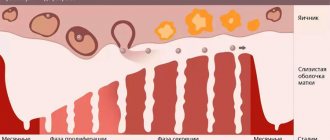The appearance of blood clots during menstruation may indicate inflammation in the female reproductive system, ovarian dysfunction, developmental abnormalities and neoplasms of the uterus, and ectopic pregnancy. This unpleasant phenomenon can be a consequence of abortion, childbirth, stress, or depression. First of all, we establish the cause and monitor the development of the ailment.
Heavy periods with clots (menorrhagia) plague every third woman. This phenomenon has different causes - normal and pathological. Let's try to determine in what cases you need a doctor, and in what cases you should not worry.
Why do blood clots that look like liver come out during menstruation?
Menstrual clots are a mixture of blood cells, tissue from the lining of the uterus, and proteins that help regulate blood flow.
The appearance of small pieces is considered normal if no other symptoms occur. Some diseases can also cause large, bloody liver-like lumps, often along with heavy menstrual bleeding or periodic pain. A woman should consult a doctor to get rid of doubts about health problems.
When are clots considered normal?
A clot is a thick mass of menstrual blood that is expelled from the body during menstruation. They most often occur during the heaviest part of your period—usually the first few days.
The pieces can be of different shapes, thick, similar to drops of jelly, vary in size and color. Seeing a thick ball of menstrual blood is strange and unpleasant, but in most cases it is a natural part of the body's defense mechanism.
The thick, jelly-like texture of the clots helps prevent too much secretion from coming out. The same coagulation function occurs in other parts of the body when tissue is damaged - cuts or lacerations.
Clots usually occur with heavy periods. They can be bright in color or darker, pinkish or dark red. Larger lesions may appear black, like pieces of liver. The discharge begins to appear darker, more brown towards the end of the period as the blood ages leaving the body slowly.
How and why are they formed?
Our bodies are designed to thicken the blood using internal chemicals to prevent us from bleeding to death. Anticoagulants released by the body during menstruation prevent lumps from forming to allow blood to escape, as well as to flush out any waste from the uterine lining.
During heavy menstruation, blood is released faster, so anticoagulants do not have enough time to destroy it. Naturally, the secretions coagulate, forming blood clots.
The consistency of menstrual flow is constantly changing. One cycle you may have a period that contains clots, but the next month you don't have any of the same. This change is natural and occurs due to dietary factors and lifestyle.
However, if your periods are regularly very heavy (you have to change your pad or tampon every hour), with a lot of large, thick clots coming out, then it is worth visiting your doctor for a health check.
Causes of pathological clots
Sometimes blood clots during your period can signal a medical problem. It is advisable to consult a doctor if you experience the following symptoms:
- The pieces are very large, appearing every cycle;
- They are discharged with heavy blood loss, which requires changing a pad or tampon every 1-2 hours
- Accompanied by severe pain throughout the entire period of menstruation.
The cause of abnormal formations is various diseases of the reproductive system. They need to be diagnosed and eliminated, then the symptoms will go away.
Uterine fibroids
Myoma is a foreign body that interferes with the normal contraction of the uterine muscles. Suspicion of fibroids arises if the following symptoms are present:
- Constant back pain in the lumbar region;
- Sex causes pain and discomfort;
- A pressing feeling appears in the lower abdomen;
- Menstruation becomes irregular;
- There are problems with fertilization.
The appearance of fibroids leads to the fact that the uterus cannot expel blood accumulations from its cavity at the required speed. Stagnation gives the secretions more time to coagulate and form lumps. As a result, you observe irregular, heavy discharges of large amounts of blood with large dark clots that look like liver.
Endometriosis and adenomyosis
Endometriosis is a pathological growth of endometrial tissue outside the uterine cavity. This condition, like fibroids, causes stagnation and the formation of blood clots.
The main symptom is severe pain, similar to contractions, and heavy bleeding. The result of advanced disease is infertility.
With adenomyosis, the same process of endometrial growth occurs, but in this case it grows into the muscle fibers of the uterine walls. As a result, its structure thickens, which makes normal contractions difficult and slows down the passage of menstruation.
Hormonal imbalance
Hormonal imbalance causes many period problems. If a woman experiences a hormonal imbalance, the consequences can be either a lack of menstruation or heavy blood loss with clots.
Miscarriage
The appearance of a large piece that looks very strange may be associated with an early miscarriage of two to three weeks.
A woman may feel a sharp sharp pain in the lower abdomen, which will result in heavy bleeding, and then the discharge of several large pieces, reminiscent of the liver.
Without knowing about pregnancy, this phenomenon can be mistaken for normal menstruation, which began a little earlier.
Bleeding disorder
There are clotting disorders, such as von Willebrand disease, that cause abnormal menstruation in women. Improper functioning of platelets leads to disruption of the normal coagulation process.
Treatment of each of these diseases requires an individual approach. Once the disease is eliminated, the abnormal clots will also disappear.
What hygiene products to use
If clots are causing discomfort, it is important to choose a hygiene product that will help control blood consistency, such as a menstrual cup.
Tampons and pads cannot absorb thick blood and debris. But menstrual cups collect both discharge and clots.
By removing the cup, you can observe the color, consistency, and amount of discharge lost during menstruation. Knowing these details helps you notice any significant changes that may be an indicator of health problems.
If you've never heard of a menstrual cup before, read up on it to find out how it works and why it's a better menstrual solution than tampons or pads.
Ways to relieve symptoms
For menstrual irregularities, the first thing you need is a diet that includes foods rich in iron. Additionally, your doctor may prescribe iron supplements, especially if you suffer from heavy blood loss and are at risk of anemia.
Also recommended:
- Drink enough water to prevent dehydration;
- Do not take aspirin, as it thins the blood and can cause severe bleeding;
- Lead an active lifestyle even during menstruation, so that the discharge does not stagnate in the uterus;
- Follow the medication regimen prescribed by your doctor.
Doctors usually suggest taking a course of hormone therapy and installing a progestin IUD. In this way, you can effectively influence your periods and normalize them.
To eliminate severe pain that accompanies most diseases associated with menstruation, it is recommended to take non-steroidal anti-inflammatory drugs.
Diclofenac, Ibuprofen, as well as their analogs will help relieve pain and inflammation.
If coagulation disorders have been identified, the doctor will prescribe special medications that normalize this function. You cannot take them on your own, only as prescribed by a specialist.
Results and forecast
Small lumps up to 1 cm in size are not a cause for concern - this is just a protective function regulated by anticoagulants.
But large formations similar to the liver against the background of heavy menstruation should alert you. If the diagnostic results reveal the above diseases, do not delay treatment.
In most cases, infertility becomes a complication of these diseases.
Source: https://mesiki.com/videleniya/sgustki-krovi/
Periods in grains. Menstruation with patches Menstruation with grains
Anasiasia, Nizhny Novgorod
Hello, you must undergo an in-person examination, a general smear and a PCR scraping for all groups of infections. It would be right not to delay your visit
Hello. I made love with my husband, I started bleeding and it hurt on the left side, the next day there was no discharge, but the aching pain remained. A year ago I cauterized cervical erosion, could this be somehow connected?
Hello. The delay was almost 10 days, there was white discharge and nausea in the morning. I went to see a doctor, she said my uterus was soft. She told me to come back in 10 days for an ultrasound.
I have such a problem in September, I had an abortion, all October everything was fine, but now I have an incomprehensible thick pinkish-brownish discharge, it doesn’t look like menstruation, although in time my menstruation should start any day now.
This discharge began on the 15th and for the past few days it has been periodically discharged, that is, it is not there, but before that on the 13th or 14th the entire lower abdomen hurt, and during sex it was not very pleasant, it even hurt.
What could it be? Could this be an aftereffect?
Hello, please explain the situation to me. On January 15, my period began without delay, but it was very strange - it smeared a little, then nothing happened until the morning.
On January 16, normal discharge began, but there was much less discharge than usual (I estimated this by the number of pads wasted, and also by the fact that they usually lasted me 6 days and it happened that even on 7 there was insignificant discharge, but this time it was 5 days and everything and then on the 5th day it just anointed). Now my chest hurts terribly, I can’t even touch my nipples.
Good afternoon. Delay 2 days, test positive. When examined by a gynecologist, pregnancy cannot be detected. On ultrasound, the uterus was said to be not much enlarged, there was fluid, but the egg was not visible. I donated blood yesterday and hCG shows 538.7. What should I do? For several days there is pain as during menstruation. There are no allocations. Is it possible it's ectopic?
Not long ago I had light brown discharge (my husband and I were pregnant within a day or two. Act, trip to the gynecologist). I am 9 weeks pregnant. They said that the uterus lags behind the fetus by a week, is this dangerous? Has anyone experienced light brown discharge?
18+ Online consultations are for informational purposes only and do not replace a face-to-face consultation with a doctor. Terms of use
Your personal data is securely protected. Payments and site operation are carried out using the secure SSL protocol.
Menstruation with clots (pieces) - causes of a frightening phenomenon
Menstruation is accompanied by many processes in a woman’s body. The central nervous system coordinates the entire monthly cycle and regulates sex hormones. If one of the links malfunctions, the nature of the discharge and the duration of menstruation change. If your period comes with blood clots - is it normal or abnormal? What does this picture indicate?
Clots are normal
The next monthly cycle begins on the first day of menstruation. A new egg is born, which will develop until and after ovulation. At the same time, the uterus prepares to receive a fertilized egg.
Under the influence of hormones, an additional layer of the uterus, the endometrium, is formed. If fertilization does not occur, the uterus begins to get rid of it. Makes contractions, pushes out everything unnecessary. Along with the blood, the remains of the endometrium of the uterus come out.
Hence menstruation with blood clots.
In addition, during critical days, a woman tries to lie down, sit more, and move less. This slows down the process of blood coming out. Once inside the vagina, it curls up.
You may notice discharge with clots on the pad. They usually appear in the middle of menstruation, or at the end.
Evidence that blood ceases to be intensely secreted, the uterus is completely cleared of epithelium.
If the discharge of blood does not differ from previous monthly periods, there is no pain or unusual discomfort, there is no reason for concern. Discharge with blood clots is normal.
Sometimes heavy periods with blood clots accompany a woman due to pathological abnormalities. This is the norm for this condition, but in general it is a deviation. These include the structure of the uterus with septa.
During menstruation, blood is retained inside, quickly clots, and discharge with blood clots appears. As well as bicornuate uterus. This abnormal phenomenon causes heavy periods with clots, accompanied by severe pain.
The problem is solved surgically.
If the discharge during menstruation is very different from usual, pathological processes in the body or a gynecological disease can be suspected.
Hormonal disbalance
Hormones are responsible for the entire process of the menstrual cycle. In the first phase, the development of the egg is ensured by the hormone estrogen. Under its influence, the uterus forms the endometrium. In the second phase, progesterone takes precedence. The hormone helps strengthen the fertilized egg to the walls of the uterus - the prepared endometrium.
If fertilization does not occur, progesterone provokes menstruation. Hormonal imbalance leads to failure of the entire reproductive system. The situation may turn out differently. The uterus forms an excess layer of endometrium, the onset of menstruation will be delayed. As a result, heavy or scanty menstruation with blood clots appears.
In the first case, the main reason for the large number of clots and heavy menstruation is the endometrial layer. In the second there is coagulated blood.
Hormonal imbalance does not mean that the cause of the malfunction is a disruption of the reproductive system. The following are responsible for the production and normal functioning of hormones:
Hormone levels are determined through a blood test, which is taken on certain days of the monthly cycle. With hormonal imbalance, monthly discharge with blood clots is always dark, accompanied by pain in the lower abdomen, fever, and nausea.
With insufficient progesterone, periods are scanty. If there is excess, there is heavy menstruation. Hormonal imbalance occurs during menopause. Then menstruation ceases to be regular, and the discharge is accompanied by blood clots.
The problem is solved by taking hormonal drugs.
Gynecological diseases
Diseases of the reproductive system are often accompanied by symptoms of varying severity. But sometimes menstrual irregularities and discharge with blood clots are the only sign of a pathological process in the body.
A fairly common disease among women of any age. The main cause of the pathology is hormonal imbalance. Endometriosis refers to diseases of the uterus. The organ produces an excessive layer of endometrium that extends beyond the uterus. All this is accompanied by aching pain on the eve of menstruation or during menstruation.
Discomfort during sexual intercourse. Detachment of the endometrium causes heavy menstruation with blood clots. After menstruation, the aching pain remains. The situation may appear once or repeat every month. Which is a good reason to see a doctor. The disease can become chronic and will make itself known periodically.
Endometriosis is one of the causes of infertility.
A disease of the genital organ, characterized by the presence of benign formations. Gynecologists divide fibroids, fibroids, and fibromyomas. Depends on the location of the tumor and the tissues that are involved in the formation. In severe cases, the neoplasm can become malignant.
Often the cause of the disease is hormonal imbalance. Very often, fibroids appear in women after 40 years before menopause. But it may be present in women of childbearing age. The main danger of the disease is the absence of symptoms. Apart from unusual discharge with blood clots, the woman does not worry about anything at first.
Fibroids may disappear over time or increase in size. Amenable to hormonal treatment. If it grows, the tumor is removed surgically. It is very important to identify the disease in a timely manner. Then the treatment will be much more effective. The tumor interferes with the free flow of blood during menstruation.
It curls up inside the genital organ. Discharge with blood clots appears on the pad.
More recently, doctors considered abortion and childbirth in adulthood to be the cause of the disease. Currently, cases of polyps occurring in young women who have not had an abortion have become more frequent. Small tumors grow on the walls of the uterus.
They provoke heavy bleeding and the formation of clots. In addition, there is pain in the lower abdomen, spotting with brown discharge throughout the entire monthly cycle.
One of the causes of the disease is hormonal imbalance, but the most important is mechanical impact.
The disease can develop at an early age. Sometimes heavy periods with clots can help you suspect health problems. It is not the accumulation of blood that is present anymore, but the presence of mucus. At a young age, menstruation is heavy. As you get older, pain increases.
There are many reasons for the appearance of menstruation with clots. It is impossible to recognize it yourself at home. You will have to undergo an examination, a diagnosis, and a long course of treatment.
Presence of an intrauterine device
Not all women are suitable for hormonal contraception. And some people deliberately do not want to use them, fearing changes in appearance and health.
The intrauterine device is a common contraceptive among women who have given birth. It is recommended to install it 6 months after childbirth, but some ladies install the spiral after 2 months.
The spiral is installed in the uterine cavity, does not cause discomfort, and is not felt during movement. But it is perceived by the body as a foreign object.
The spiral affects the nature of discharge during menstruation. During the first 3 months, the body and reproductive system adapt to the contraceptive. At this time, menstruation becomes heavy with clots. Duration more than 7 days.
There is no particular pain, there is general weakness and malaise. In some cases, dizziness occurs. In the period between menstruation, brown discharge and a small amount of clots may be observed. Within 3 months, menstruation returns to normal.
Sometimes the amount of blood released and the duration of critical days become the same.
If the situation with clots and heavy bleeding recurs, you should consult a doctor. The presence of other painful sensations along with heavy discharge may indicate inflammation. The cause of the disease and discharge with the presence of a large number of clots is the spiral.
Abortion, childbirth, miscarriage - periods in pieces
The cause of heavy discharge with the presence of clots may be a previous abortion. This may be the body's reaction to hormonal imbalance and physical intervention.
Or else indicate incomplete removal of the embryo, the presence of an inflammatory process. A similar situation with the remaining part of the fetus can occur as a result of a vacuum abortion, or a mini-abortion using pills.
Heavy menstruation with the presence of clots and with pieces during curettage is a consequence of injury to the organ.
After giving birth, a woman will have to go through the process of restoring her monthly cycle. All sorts of deviations are possible with a delay in menstruation, a violation of the duration of menstruation. Heavy bleeding with clots is also possible. The situation should not be ignored. It is necessary to visit a gynecologist to rule out diseases and pathological processes.
Miscarriage or voluntary termination of pregnancy often occurs in the first 12 weeks after conception. Sometimes a woman has no idea about pregnancy at all, and after a short delay of 1-3 weeks, her period begins.
At the same time, the discharge is more abundant than it was before. The consistency is not homogeneous with blood clots. It is advisable for a woman to undergo an ultrasound to make sure that the uterus has cleared itself.
In other cases, additional curettage is performed.
Drugs to induce menstruation
Free access to the Internet has given the modern woman the opportunity to solve her problems without the help of a doctor. The situation with delayed periods is discussed on the forums.
There, women give each other advice on how to induce menstruation. It is not difficult to guess that menstruation can be delayed for many reasons. The solution to the problem is purely individual.
Meanwhile, women go to the pharmacy and buy drugs to induce menstruation.
Menstruation with clots is the result of using Duphaston, Norkolut. These are the most common remedies among women. You need to take the tablets 2 times a day for 10 days. At the end of the period, your period comes.
In some women this happens after 3-5 days of using the drug. These pills contain a large amount of progesterone.
If the body's hormone balance is disturbed, and the delay is not due to a lack of progesterone, the drugs will cause heavy menstruation and clots (pieces of blood).
Menstruation with blood clots should not be ignored. A woman should analyze the situation, the amount of discharge, and assess her general well-being. If the situation is concerning, you should visit a gynecologist. In most cases, the problem is solved by qualified treatment. Independent efforts will not bring results.
WHAT TO DO IF YOU HAVE A FIBROID, CYST, INFERTILITY OR OTHER DISEASE?
- You are experiencing sudden abdominal pain.
- And I’m already quite tired of long, chaotic and painful periods.
- You do not have enough endometrium to become pregnant.
- Discharge that is brown, green or yellow.
- And for some reason the recommended medications are not effective in your case.
- In addition, constant weakness and ailments have already become a firm part of your life.
An effective remedy for the treatment of endometriosis, cysts, fibroids, unstable menstrual cycle and other gynecological diseases exists. Follow the link and find out what the chief gynecologist of Russia recommends to you
Why are they going?
In the first 2-3 days of menstruation, heavy discharge with clots is a normal phenomenon: rejected parts of the mucous membrane, secretions, and blood that has coagulated in the vagina come out. At the last stage of menstruation, there are almost no clots. If your period follows this scenario, then you are fine.
Clots in menstrual blood should not worry you if:
- You are under 18 years of age;
- You recently gave birth;
- You are premenopausal;
- Recently had an abortion, miscarriage, surgical or diagnostic curettage;
- You have been diagnosed with uterine abnormalities that interfere with the free flow of blood (for example, a bend);
- You use oral and intrauterine contraception, drugs that induce menstruation.
In these cases, the appearance of clots in menstrual blood is explained by a hormonal state or characteristics of the body. Watch yourself. If the clots are temporary, there is no need to worry.
If none of this is present, but menorrhagia with blood clots is present, there is cause for concern. Let's look at the possible causes of thickening of menstrual blood.











